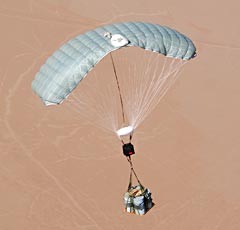JPADS basic weight class focuses on low-cost systems such as the Screamer and Affordable Guided Airdrop System (AGAS), developed by Capewell Components Company, LLC of South Windsor, Connecticut and Vertigo, Inc. of Lake Elsinore, California. This system is designed to deliver military payloads weighing up to 2,200 lbs. (1 ton) using standard army cargo parachutes and containers. For safety, landing velocity is minimized reducing hazards to personnel and other cargo within the drop zone. AGAS utilizes conventional parachutes (G-12 flat, circular cargo parachute and A-22 Container Delivery System (CDS).
 The system can also be used for accurate high-altitude release and is claimed to offer greater safety, reliability and accuracy compared to high glide delivery. AGAS system includes an auto-pilot linked to a GPS-based guidance, navigation and control system and weather data mode embedded in an airdrop Mission Planning (MP) tool. Optimizing the flight plan based on an accurate profile of winds that it will encounter over the drop zone the auto-pilot guides the delivery system to the designated drop-zone at near-pinpoint accuracy. During tests conducted by the U.S. Army in 2004 and 2005, 11 AGAS units were dropped over a three day period from 13,000 feet Mean Sea Level (MSL) achieving a Circular Error Probable (CEP) of 50m. These systems demonstrated their ability by flying to multiple drop zones, when three units were released in a single airdrop pass with each flying to a different target on the drop zone.
The system can also be used for accurate high-altitude release and is claimed to offer greater safety, reliability and accuracy compared to high glide delivery. AGAS system includes an auto-pilot linked to a GPS-based guidance, navigation and control system and weather data mode embedded in an airdrop Mission Planning (MP) tool. Optimizing the flight plan based on an accurate profile of winds that it will encounter over the drop zone the auto-pilot guides the delivery system to the designated drop-zone at near-pinpoint accuracy. During tests conducted by the U.S. Army in 2004 and 2005, 11 AGAS units were dropped over a three day period from 13,000 feet Mean Sea Level (MSL) achieving a Circular Error Probable (CEP) of 50m. These systems demonstrated their ability by flying to multiple drop zones, when three units were released in a single airdrop pass with each flying to a different target on the drop zone.
Similar performance is provided by the Onyx, developed by Brooklyn based Atair supports 500 and 2,000 lbs (0.2 – 1 ton) class payloads utilizing hybrid elliptical ram-air/round canopy design. The Canadian Sherpa, developed by Mist Mobility Integrated Systems Technology, Inc. (MMIST) also supports payload capacities of up to 2,200 lbs (1 ton). Parafly offers the FireFly carrying 500 – 2,200 lbs (0.2 – 1 ton). An interesting feature introduced with the FireFly is the roadway landing feature, enabling the user to designate an azimuth for landing rather than the default into-the-wind heading to take advantage of roads and other paved surfaces for cargo retrieval.
The first JPADS-XL combat airdrops took place on Aug. 31, 2006 in Afghanistan. Following the successful demonstration, by early 2007, several JPADS XL systems were acquired by US Joint Forces Command (USJFCOM) and deployed in Afghanistan to support US Special Forces. According to Bob Hartling, Limited Authority Acquisition (LAA) branch head at USJFCOM, the systems proved very so successful in their pre-deployment phase that combatant demand for JPADS 2,000 lbs (1 ton) systems in the battlefield has surged. “It has been considered as a means for reducing the number of convoys in other regions, as the cargo pallets can now be deployed to different specific locations from a single aircraft, rather than the traditional deployment of all pallets along a single multi-mile delivery corridor,” said Hartling. By February 2007 the systems were also deployed in Iraq, where aircrew members from the 332nd Air Expeditionary Wing’s 777th Expeditionary Airlift Squadron used JPADS for the first time to deliver six 1,200 lbs (545 kg) bundles.
Read additional parts of this article:




















